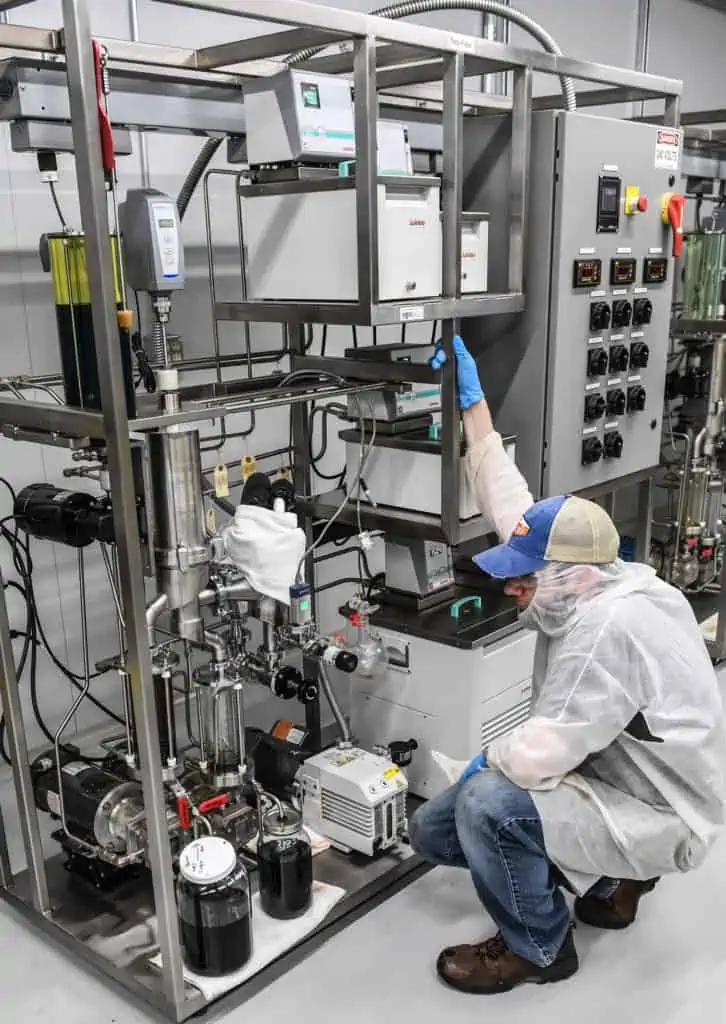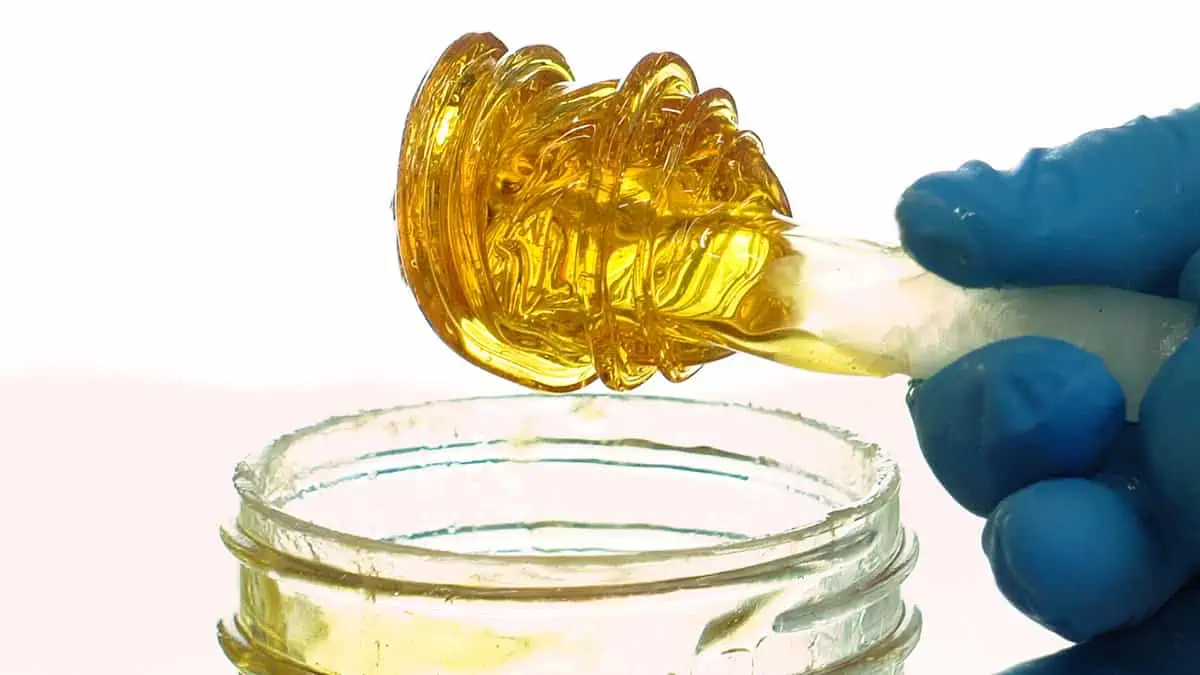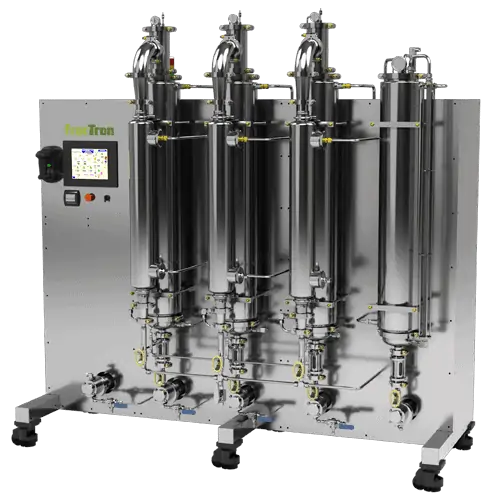The step of solvent removal in CBD extraction and formulation is not just important, it is essential to creating a product that is pure and safe for consumption. In this article, we explain what solvent removal is, why it’s crucial and the best answer to total solvent removal from extracts.
What is Solvent Removal?
In a nutshell, solvent removal is necessary to recover, or remove solvent from CBD oil after ethanol extraction or winterization.
This is accomplished by applying vacuum pressure and heat to a thin film of oil causing it to evaporate from the oil before condensing and collecting in a receiver flask, or other capture vessel.
Because the cannabinoids have a higher boiling point than the solvent, it remains in the oil while the vacuum pressure lowers the necessary temperature further to reduce any damage to the cannabinoids.
After the solvent has been collected, it can be disposed of, or recycled for extraction and winterization.
Now that we’ve explained the process, let’s look at some common tech used to accomplish this important process in manufacturing CBD extracts.

Rotary Evaporators:
A rotary evaporator, commonly referred to as a “rotovap,” may be the most common way to accomplish solvent removal in the hemp industry. This form of equipment uses a large, rotating, round bottom flask, vacuum pump, heating bath, chilled condensation surface and collecting flask.
The vacuum pump is necessary to reduce the boiling point of solvents like ethanol as to prevent cannabinoid damage with higher temperatures. The ethanol boiling point is roughly 78.2℃ compared to a relative boiling point of 160-180℃ for CBD making it easier to volatilize the solvent fully and leave an oil consisting primarily of cannabinoids and terpenes.
To further ease the removal of residual solvents, a rotovap creates a thin film of oil on the inside of the rotating flask. As it rests in the heating bath, the rotation makes the oil thin enough to increase the rate of evaporation. Once it has fully evaporated, most rotovaps will use a chilled condenser to collect the evaporated solvents where it will collect into a receiving flask.
While a rotovap is an effective ethanol remover and common in the ethanol extraction process, they are not without their drawbacks. An obvious disadvantage is the large glassware necessary for a rotovap to operate.
Both the large rotating flask and receiving flask are able to break under a number of circumstances causing product or solvent loss and the need for new glassware.
Rotovaps are an effective means of solvent distillation, but it’s very unlikely that only one could be used for any sizable hemp extraction process. With a throughput of roughly 5-10L /hour, it is not uncommon to have 5-10 rotovaps in a single solvent removal system depending on the manufacturer. This means more breakable glass, more equipment that can go wrong, and more hands needed to monitor the equipment.
The truth is that rotovaps are common in this industry because they work. However, there are alternative methods that have clear advantages – namely falling film evaporation.

Falling Film Evaporators
Similar to rotovaps, falling film evaporators are largely used to remove a solvent from a liquid mixture by evaporating the more volatile solvent and leaving a more purified CBD oil. Compared to other solvent removal equipment, however, falling film evaporators have a higher heated surface area per footprint, and are much better equipped to distill a solvent at a high throughput.
Unlike equipment like rotovaps that create a thin film of oil by mechanical means, falling film evaporators use gravity to create the evaporative film. They are vertical in orientation, and have a bundle of metal tubes in a metal container.
The metal tubes are then heated with a flowing media and the heat is transferred to the liquid mixture to evaporate the volatile component as the mixture flows down the tubes. Most common single stage falling film evaporators have high surface area and can be set to a single temperature.
Distillation of liquid mixtures with high ratios of solvent to extract results in drastic changes in physical properties of the mixture as the distillation proceeds. Removing the last percentages of ethanol compared to the first is far more difficult with a single pass system with only one temperature setpoint.
As the liquid mixture flows through the tubes of the falling film evaporator, it changes composition due to evaporation of the volatile solvent. The change in composition changes the physical properties of the macroscopic mixture – including the boiling point. While single stage systems struggle to accomplish full removal of solvent because of this, extraktLAB’s fracTron 1000 utilizes a triple pass falling film system to change the operating temperature of the evaporator as the composition of the liquid mixture changes.
By doing this, the three-stage distillation in the fracTron 1000 far more effectively removes the last remaining percentages of ethanol or other solvents. As the ethanol/oil mixture moves through each of the three passes, temperatures and vacuum pressures can be adjusted to compensate for increased boiling points and viscosities where other evaporation methods would have difficulty. This creates an optimal removal of solvents before the final process of distillation.
The Right Choice?
A more complete solvent removal process is just the tip of the iceberg when it comes to the advantages of the fracTron 1000. Stainless steel construction, GMP compliance and a 40 Gallon/Hour throughput make this equipment the ideal solvent removal machine in your production line. Remember; solvent removal is important for purity and consumer safety. Why not use the optimal equipment to ensure that bottom line?
Interested in upgrading your solvent removal equipment? Give us a call at 651-600-0036 to consult one of our specialists and get a quote today!



